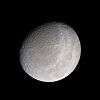Naming of moons
The naming of moons has been the responsibility of the International Astronomical Union's committee for Planetary System Nomenclature since 1973. That committee is known today as the Working Group for Planetary System Nomenclature (WGPSN).
Prior to its formation, the names of satellites have had varying histories. The choice of names is often determined by a satellite's discoverer; however, historically some satellites were not given names for many years after their discovery; for instance, Titan was discovered by Huygens in 1655, but was not named until 1847, almost two centuries later.
Before the IAU assumed responsibility for astronomical nomenclature, only twenty-five satellites had been given names that were in wide use and are still used.[1] Since then, names have been given to 129 additional satellites: 45 satellites of Jupiter, 43 of Saturn, 22 of Uranus, 11 of Neptune, 5 of Pluto, 1 of Eris, and 2 of Haumea. The number will continue to rise as current satellite discoveries are documented and new satellites are discovered.
At the IAU General Assembly in July 2004,[2] the WGPSN suggested it may become advisable to not name small satellites, as CCD technology makes it possible to discover satellites as small as 1 km in diameter. To date, however, names have been applied to all moons discovered, regardless of size.
Naming of moons by solar system object
Earth
Every human language has its own word for the Earth's Moon, and these words are the ones normally used in astronomical contexts. However, a number of fanciful or mythological names for the Moon have been used in the context of astronomy (an even larger number of lunar epithets have been used in non-astronomical contexts). In the 17th century, the Moon was sometimes referred to as Proserpina. More recently, especially in science-fictional contexts, the Moon has been called by the Latin name Luna, presumably on the analogy of the Latin names of the planets, or by association with the adjectival form lunar. In technical terminology, the word-stems seleno- (from Greek selēnē "moon") and cynthi- (from Cynthia, an epithet of the goddess Artemis) are sometimes used to refer to the Moon, as in selenography, selenology, and pericynthion.
Mars
The moons of Mars (Phobos and Deimos) were named by Asaph Hall in 1878, soon after he discovered them. They are named after the sons of the god Ares (the Greek equivalent of the Roman god Mars).
Jupiter
The Galilean moons of Jupiter (Io, Europa, Ganymede and Callisto) were named by Simon Marius soon after their discovery in 1610. However, by the late 19th century these names had fallen out of favor, and for a long time it was most common to refer to them in the astronomical literature simply as "Jupiter I", "Jupiter II", etc., or as "the first satellite of Jupiter", "Jupiter's second satellite", etc.
By the first decade of the 20th century, the names Io, Europa, Ganymede, and Callisto had once again recovered popularity, but the later-discovered moons, numbered, usually in Roman numerals V (5) through XII (12), remained unnamed.[3] By a popular though unofficial convention, Jupiter V, discovered in 1892, was given the name Amalthea,[4] first used by the French astronomer Camille Flammarion.[5]
The other moons (discovered 1904 to 1951) were, in the overwhelming majority of astronomical literature, simply left nameless. No names were proposed until Brian G. Marsden suggested a nomenclature for these satellites in 1955.[6] Although the 1955 names met with immediate acceptance in some quarters (e.g. in science fiction[7] and popular science articles[8]), they were still rarely if ever met in astronomical literature until the 1970s.[9]
Two other proposals for naming the satellites were made between 1955 and 1975, both by Soviet astronomers, E. I. Nesterovich (in 1962) and Yu. A. Karpenko (in 1973).[10] These met with no very enthusiastic reception.
In 1975, following Charles Kowal's discovery of the satellite Jupiter XIII in 1974 the IAU Task Group for Outer Solar System Nomenclature granted names to satellites V-XIII, and provided for a formal naming process for future satellites to be discovered. Under the new process, Jupiter V continued as Amalthea, Jupiter XIII was named Leda in accordance with a suggestion of Kowal's, and all previous proposals for the seven satellites VI-XII were abandoned in favor of new names, in accordance with a scheme suggested by the German philologist Jürgen Blunck where prograde moons received names ending in 'a' and retrograde moons received names ending in 'e'.[11]
The new names met considerable protest from some quarters. Kowal, despite suggesting a name for Jupiter XIII, was of the opinion that Jupiter's irregular satellites should not be named at all.[12] Carl Sagan noted that the names chosen were extraordinarily obscure (a fact that Tobias Owen, chair of the Task Group, admitted was intentional in a response to Sagan[10]) and suggested his own names in 1976;[13] these preserved some of the names from the 1955 proposal.
The proposals are summarized in the table below (data from Icarus[10][13])
| Number | 1955 Proposal Brian Marsden[6] |
1962 Proposal E. I. Nesterovich[14] |
1973 Proposal Yu. A. Karpenko[15] |
1975 Proposal IAU Committee[10] |
1976 Proposal Carl Sagan[13] |
|---|---|---|---|---|---|
| Jupiter VI | Hestia | Atlas | Adrastea | Himalia | Maia |
| Jupiter VII | Hera | Hercules | Ida | Elara | Hera |
| Jupiter VIII | Poseidon | Persephone | Helen | Pasiphae | Alcmene |
| Jupiter IX | Hades | Cerberus | Leda | Sinope | Leto |
| Jupiter X | Demeter | Prometheus | Latona | Lysithea | Demeter |
| Jupiter XI | Pan | Dedalus | Danae | Carme | Semele |
| Jupiter XII | Adrastea | Hephaestus | Semele | Ananke | Danae |
Current practice is that newly discovered moons of Jupiter must be named after lovers of the mythological Jupiter (Zeus). Blunck's scheme for the outer moons was retained, with the addition that names ending in 'o' could also be used for prograde moons. At the IAU General Assembly in July 2004,[2] the WGPSN therefore allowed Jovian satellites to be named for Zeus' descendants in addition to his lovers and favorites which were the previous source of names. All of Jupiter's satellites from XXXIV (Euporie) on were named for daughters of Zeus, until Jupiter LIII (Dia), named after another one of his conquests.
Saturn
In 1847 the seven then known moons of Saturn were named by John Herschel. Herschel named Saturn's two innermost moons (Mimas and Enceladus) after the mythological Greek Giants, and the outer five after the Titans (Titan, Iapetus) and Titanesses (Tethys, Dione, Rhea) of the same mythology. Until then, Titan was known as the "Huygenian (or Huyghenian) satellite of Saturn" and the other moons had Roman numeral designations in order of their distance from Saturn. Subsequent discoverers of Saturnian moons followed Herschel's scheme: Hyperion was discovered soon after in 1848, and the ninth moon, Phoebe, was named by its discoverer in 1899 soon after its discovery; they were named for a Titan and a Titaness respectively. The name of Janus was suggested by its discoverer, Audouin Dollfus.
Current IAU practice for newly discovered inner moons is to continue with Herschel's system, naming them after Titans or their descendants. However, the increasing number of moons that were being discovered in the 21st century caused the IAU to draw up a new scheme for the outer moons. At the IAU General Assembly in July 2004,[2] the WGPSN allowed satellites of Saturn to have names of giants and monsters in mythologies other than the Greco-Roman. Since the outer moons fall naturally into three groups, one group is named after Norse giants, one after Gallic giants, and one after Inuit giants. The only moon that fails to fit this scheme is the Greek-named Phoebe, which is in the Norse group.
Uranus
The Roman numbering scheme of Uranus' moons was in a state of flux for a considerable time. Sir William Herschel thought he had discovered up to six moons and maybe even a ring. For nearly fifty years, Herschel's instrument was the only one the moons had been seen with.[16] In the 1840s, better instruments and a more favourable position of Uranus in the sky led to sporadic indications of satellites additional to Titania and Oberon. Publications hesitated between William Herschel's designations (where Titania and Oberon are Uranus II and IV) and William Lassell's (where they are sometimes I and II).[17] With the confirmation of Ariel and Umbriel, Lassell numbered the moons I through IV from Uranus outward, and this finally stuck.[18]
The first two Uranian moons, discovered in 1787, did not receive names until 1852, a year after two more moons had been discovered. The responsibility for naming was taken by John Herschel, son of the discoverer of Uranus. Herschel, instead of assigning names from Greek mythology, named the moons after magical spirits in English literature: the fairies Oberon and Titania from William Shakespeare's A Midsummer Night's Dream, and the sylphs Ariel and Umbriel from Alexander Pope's The Rape of the Lock (Ariel is also a sprite in Shakespeare's The Tempest). The reasoning was presumably that Uranus, as god of the sky and air, would be attended by spirits of the air.
Subsequent names, rather than continuing the "airy spirits" theme (only Puck and Mab continuing the trend), have focused on Herschel's source material. In 1949, the fifth moon, Miranda, was named by its discoverer, Gerard Kuiper, after a thoroughly mortal character in Shakespeare's The Tempest. Current IAU practice is to name moons after characters from Shakespeare's plays and The Rape of the Lock (although at present only Ariel, Umbriel, and Belinda have names drawn from the latter poem, all the rest being from Shakespeare). At first, the outermost moons were all named after characters from one play, The Tempest; but with Margaret being named from Much Ado About Nothing that trend has ended.
Neptune
The one known moon (at the time) of Neptune was not named for many decades. Although the name Triton was suggested in 1880 by Camille Flammarion, it did not come into general use until the mid 20th-century, and for many years was considered "unofficial". In the astronomical literature it was simply referred to as "the satellite of Neptune". Later, the second known moon, Nereid, was named by its discoverer in 1949, Gerard P. Kuiper, soon after its discovery.
Current IAU practice for newly discovered Neptunian moons is to accord with these first two choices by naming them after Greek sea deities.
Pluto

The name of Pluto's moon Charon was suggested by James W. Christy, its discoverer, soon after its discovery.
The other four moons are named Hydra, Nix, Kerberos, and Styx.
Charon, Hydra, Nix, and Kerberos are all characters in Greek mythology, with ties to Hades (the Greek equivalent of Pluto). Charon ferries the dead across the River Acheron, Hydra guards the waters of the underworld, and Nix (a respelling of Nyx), mother of Charon, is the goddess of darkness and the night. Kerberos is a giant three-headed dog who guards the entrance to the underworld. The fifth moon is named for the river Styx that forms the boundary between the worlds of the living and the dead.
Eris
The name of Eris's moon Dysnomia was suggested by its discoverer Michael E. Brown, who also suggested the name of the dwarf planet. The name has two meanings: in mythology Dysnomia (lawlessness) is the daughter of Eris (chaos). However, the name is also an intentional reference to the actor Lucy Lawless who plays the character Xena. The background for this is that during the long period when Eris had no formal name, the name 'Xena' – originally Brown's nickname for his discovery – spread and became popular. When the name 'Eris' was chosen, Brown suggested Dysnomia (which until then had been referred to as Gabrielle) as a reference to this.[20] Hence, Dysnomia is the only moon which could be said to be named after an actor. The names Eris and Dysnomia were accepted by the IAU on 14 September 2006.
Haumea
The name of Haumea and its moons were suggested by David L. Rabinowitz of Caltech and refer to the mother goddess and her daughters in Hawaiian mythology.
Asteroids and Kuiper Belt Objects
Unlike the planets and dwarf planets, relatively few moons orbiting asteroids have been named. Among them are the following:
| Name of moon | Name of primary | Roman numeral |
|---|---|---|
| Dactyl | 243 Ida | I |
| Echidna | 42355 Typhon | I |
| Linus | 22 Kalliope | I |
| Menoetius | 617 Patroclus | I |
| Petit-Prince | 45 Eugenia | I |
| Phorcys | 65489 Ceto | I |
| Remus | 87 Sylvia | II |
| Romulus | 87 Sylvia | I |
| Sawiskera | 88611 Teharonhiawako | I |
| Zoe | 58534 Logos | I |
Roman numeral designations
The Roman numbering system for satellites arose with the very first discovery of natural satellites other than Earth's Moon: Galileo referred to the Galilean moons as I through IV (counting from Jupiter outward), refusing to adopt the names proposed by his rival Simon Marius. Similar numbering schemes naturally arose with the discovery of multiple moons around Saturn, Uranus, and Mars. The numbers initially designated the moons in orbital sequence, and were re-numbered after each new discovery; for instance, before the discovery of Mimas and Enceladus in 1789, Tethys was Saturn I, Dione Saturn II, etc.,[21] but after the new moons were discovered, Mimas became Saturn I, Enceladus Saturn II, Tethys Saturn III and Dione Saturn IV.
In the middle of the 19th century, however, the numeration became fixed, and later discoveries failed to conform with the orbital sequence scheme. Amalthea, discovered in 1892, was labelled "Jupiter V" although it orbits more closely to Jupiter than does Io (Jupiter I). The unstated convention then became, at the close of the 19th century, that the numbers more or less reflected the order of discovery, except for prior historical exceptions (see Timeline of discovery of Solar System planets and their natural satellites); though if a large number of satellites were discovered in a short span of time, the group could be numbered in orbital sequence, or according to other principles than strictly by order of discovery. The convention has been extended to natural satellites of minor planets, such as (87) Sylvia I Romulus.
Roman numerals are usually not assigned to satellites until they are named, so many satellites that have been discovered but only have provisional designations do not have Roman numerals assigned to them. (An exception is Saturn's moon Helene, which received the Roman numeral XII in 1982, but was not named until 1988.) Since the International Astronomical Union began assigning names to all satellites in 1975, the use of Roman numeral designations has diminished, and some are very rarely used; Phobos and Deimos are rarely referred to as Mars I and Mars II, and the Moon is never referred to as "Earth I".
The thirteen named satellites of Saturn from Aegir to Surtur were named in alphabetical order corresponding to their Roman numerals.
Provisional designations
When satellites are first discovered, they are given provisional designations such as "S/2010 J 2" (the 2nd new satellite of Jupiter discovered in 2010) or "S/2003 S 1" (the 1st new satellite of Saturn discovered in 2003). The initial "S/" stands for "satellite", and distinguishes from such prefixes as "D/", "C/", and "P/", used for comets. The designation "R/" is used for planetary rings. These designations are sometimes written like "S/2003 S1", dropping the second space. The letter following the category and year identifies the planet (Jupiter, Saturn, Uranus, Neptune; although no occurrence of the other planets is expected, Mars and Mercury are disambiguated through the use of Hermes for the latter). Pluto was designated by P prior to its recategorization as a dwarf planet. When the object is found around a minor planet, the identifier used is the latter's number in parentheses. Thus, Dactyl, the moon of 243 Ida, was at first designated "S/1993 (243) 1". Once confirmed and named, it became (243) Ida I Dactyl. Similarly, the fourth satellite of Pluto, Kerberos, discovered after Pluto was categorized as a dwarf planet and assigned a minor planet number, was designated S/2011 (134340) 1 rather than S/2011 P 1,[22] though the New Horizon team, who disagreed with the dwarf planet classification, used the latter.
Note: The assignation of "H" for Mercury is specified by the USGS Gazetteer of Planetary Nomenclature; since they usually follow IAU guidelines closely, this is very likely the IAU convention, but confirmation is needed.
After a few months or years, when a newly discovered satellite's existence has been confirmed and its orbit computed, a permanent name is chosen, which replaces the "S/" provisional designation. However, in the past, some satellites remained unnamed for surprisingly long periods after their discovery.
Timeline
Pre-IAU names
The following names were adopted by informal processes preceding the assumption by the IAU of control over the assignment of satellite nomenclature in 1973.
| Date | Namer | Name | Image | Planet/Number Designation | Discovery date | References/Notes |
|---|---|---|---|---|---|---|
| 17th century | ||||||
| 1614 | Simon Marius | Io | 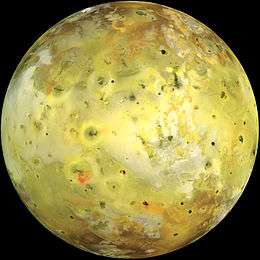 | Jupiter I | 1610 | Marius (Simon Mayr), in his book Mundus Iovialis anno M.DC.IX Detectus Ope Perspicilli Belgici, names the Galilean moons, and attributes the suggestion to Johannes Kepler. |
| Europa |  | Jupiter II | ||||
| Ganymede |  | Jupiter III | ||||
| Callisto | 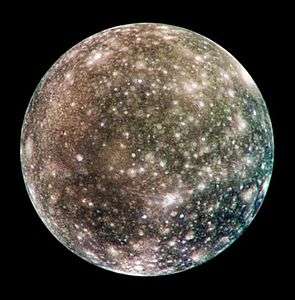 | Jupiter IV | ||||
| 19th century | ||||||
| 1847 | John Herschel | Mimas | 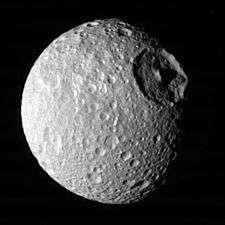 | Saturn I | 1789 | Herschel named the seven known satellites of Saturn in his book Results of Astronomical Observations made at the Cape of Good Hope, as reported by William Lassell, Monthly Notices of the Royal Astronomical Society, Vol. 8, No. 3, pp. 42–43 January 14, 1848 |
| Enceladus |  | Saturn II | ||||
| Tethys |  | Saturn III | 1684 | |||
| Dione |  | Saturn IV | ||||
| Rhea | _from_Voyager_1.jpg) | Saturn V | 1672 | |||
| Titan |  | Saturn VI | 1655 | |||
| Iapetus |  | Saturn VIII | 1671 | |||
| 1848 | William Lassell | Hyperion | | Saturn VII | 1847 | Lassell, following John Herschel's suggested scheme, names Hyperion Discovery of a New Satellite of Saturn, Monthly Notices of the Royal Astronomical Society, Vol. 8, No. 9, pp. 195–197. |
| 1852 | John Herschel | Ariel | .jpg) | Uranus I | 1851 | Herschel named the four known satellites of Uranus in Astronomische Nachrichten, Vol. 34, No. 812, pp. 325/326, 21 June 1852 (communication dated 26 May 1852.) |
| Umbriel | 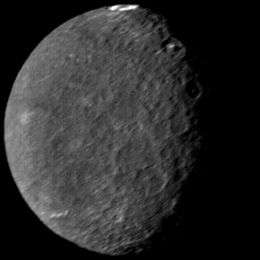 | Uranus II | ||||
| Titania | _color_cropped.jpg) | Uranus III | 1787 | |||
| Oberon |  | Uranus IV | ||||
| 1878 | Asaph Hall | Phobos | | Mars I | 1877 | Hall named his two newly discovered satellites of Mars Phobus and Deimus: Astronomische Nachrichten, Vol. 92, No. 2187, pp. 47/48 14 March 1878 (signed 7 February 1878). The names were subsequently amended to Phobos and Deimos. |
| Deimos |  | Mars II | ||||
| 1880 | Camille Flammarion | Triton | .jpg) | Neptune I | 1846 | Flammarion suggested the name Triton in his 1880 book Astronomie populaire, p. 591. The name was considered unofficial for decades afterwards. |
| c. 1893 | Camille Flammarion | Amalthea | | Jupiter V | 1892 | Flammarion suggested the name Amalthea in correspondence with discoverer E. E. Barnard. Barnard declined to propose any name, however, and Amalthea remained an unofficial name until its adoption by the IAU in 1975. |
| April 1899 | William Henry Pickering | Phoebe |  | Saturn IX | 1899 | Pickering suggested the name Phoebe in A New Satellite of Saturn, Astrophysical Journal, Vol. 9, No. 4, pp. 274–276, April 1899, by his brother Edward C. Pickering. |
| 20th century | ||||||
| April 1939 | Seth Barnes Nicholson declines to name satellites of Jupiter he has discovered (Publications of the Astronomical Society of the Pacific, Vol. 51, No. 300, pp. 85–94, signed March 1939) | |||||
| June 1949 | Gerard P. Kuiper | Miranda |  | Uranus V | 1948 | Kuiper proposed the name Miranda in his report of the discovery, The Fifth Satellite of Uranus, Publications of the Astronomical Society of the Pacific, Vol. 61, No. 360, p. 129, June 1949. |
| August 1949 | Gerard P. Kuiper | Nereid |  | Neptune II | 1949 | Kuiper proposed the name Nereid in his report of the discovery, The second satellite of Neptune, Publications of the Astronomical Society of the Pacific, Vol. 61, No. 361, pp. 175–176, August 1949. |
| 1 February 1967 | Audouin Dollfus | Janus |  | Saturn X | 1966 | Dollfus named Janus in a report of 1 February 1967 relating to its discovery (IAUC 1995: Saturn X (Janus)). |
IAU names
The following names were selected through a formal process controlled by the IAU. Only in a few cases is the person who chose the name identified.
20th century
| IAU Names - 20th century | ||||||
|---|---|---|---|---|---|---|
| Date | Name | Image | Planet/Number Designation | Discovery date | References/Notes | |
| 7 October 1975 | Himalia | Jupiter VI | 1904 | IAUC 2846: Satellites of Jupiter. Also confirmed the name Amalthea. | ||
| Elara | Jupiter VII | 1905 | ||||
| Pasiphaë | Jupiter VIII | 1908 | ||||
| Sinope | Jupiter IX | 1914 | ||||
| Lysithea | Jupiter X | 1938 | ||||
| Carme | Jupiter XI | |||||
| Ananke | Jupiter XII | 1951 | ||||
| Leda | Jupiter XIII | 1974 | ||||
| 1982 | Epimetheus | 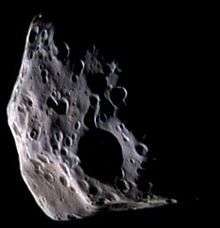 | Saturn XI | 1980 | Transactions of the International Astronomical Union, Vol. XVIIIA, 1982. Mentioned in IAUC 3872. Also confirmed the name Janus. | |
| Telesto | | Saturn XIII | ||||
| Calypso | | Saturn XIV | ||||
| 30 September 1983 | Thebe |  | Jupiter XIV | 1979 | IAUC 3872: Satellites of Jupiter and Saturn | |
| Adrastea | | Jupiter XV | ||||
| Metis | | Jupiter XVI | ||||
| 30 September 1983 | Atlas |  | Saturn XV | 1980 | IAUC 3872: Satellites of Jupiter and Saturn | |
| 3 January 1986 | Prometheus |  | Saturn XVI | IAUC 4157: Satellites of Saturn and Pluto | ||
| Pandora | | Saturn XVII | ||||
| 3 January 1986 | Charon | .jpg) | Pluto I | 1978 | IAUC 4157: Satellites of Saturn and Pluto. James W. Christy announced the name Charon shortly after his discovery of the satellite in 1978, but the name remained unofficial until its adoption by the IAU in 1986. | |
| 8 June 1988 | Helene |  | Saturn XII | 1980 | IAUC 4609: Satellites of Saturn and Uranus | |
| 8 June 1988 | Cordelia | Uranus VI | 1986 | IAUC 4609: Satellites of Saturn and Uranus | ||
| Ophelia | Uranus VII | |||||
| Bianca | Uranus VIII | |||||
| Cressida | Uranus IX | |||||
| Desdemona | Uranus X | |||||
| Juliet | Uranus XI | |||||
| Portia | Uranus XII | |||||
| Rosalind | Uranus XIII | |||||
| Belinda | Uranus XIV | |||||
| Puck | 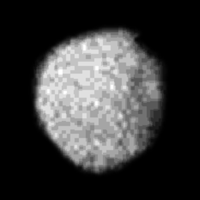 | Uranus XV | 1985 | |||
| 16 September 1991 | Pan | | Saturn XVIII | 1990 | IAUC 5347: Satellites of Saturn and Neptune | |
| 16 September 1991 | Naiad | Neptune III | 1989 | IAUC 5347: Satellites of Saturn and Neptune | ||
| Thalassa | Neptune IV | |||||
| Despina | Neptune V | |||||
| Galatea | Neptune VI | |||||
| Larissa | | Neptune VII | ||||
| Proteus | .jpg) | Neptune VIII | ||||
| 30 April 1998 | Caliban | Uranus XVI | 1997 | B. J. Gladman, P. D. Nicholson, J. A. Burns, J. J. Kavelaars, B. G. Marsden, G. V. Williams and W. B. Offutt propose the names Caliban and Sycorax in their account of the discovery: Gladman, B. J.; Nicholson, P. D.; Burns, J. A.; Kavelaars, J. J.; Marsden, B. G.; Williams, G. V.; Offutt, W. B. (1998). "Discovery of two distant irregular moons of Uranus". Nature. 392 (6679): 897–899. Bibcode:1998Natur.392..897G. doi:10.1038/31890.. (The IAU appears to have adopted these names prior to those reported in IAUC 7479.) | ||
| Sycorax | Uranus XVII | |||||
| 21 August 2000 | Prospero | Uranus XVIII | 1999 | IAUC 7479: Satellites of Uranus | ||
| Setebos | Uranus XIX | |||||
| Stephano | Uranus XX | |||||
21st century
| IAU Names - 21st century | ||||||
|---|---|---|---|---|---|---|
| Date | Name | Image | Planet/Number Designation | Discovery date | References/Notes | |
| 22 October 2002 | Callirrhoë | Jupiter XVII | 1999 | IAUC 7998: Satellites of Jupiter | ||
| Themisto | Jupiter XVIII | 2000 | ||||
| Megaclite | Jupiter XIX | 2001 | Spelled "Magaclite" in IAUC 7998; corrected 29 November 2002 in IAUC 8023: Satellites of Jupiter. | |||
| Taÿgete | Jupiter XX | IAUC 7998: Satellites of Jupiter | ||||
| Chaldene | Jupiter XXI | |||||
| Harpalyke | Jupiter XXII | 2000 | ||||
| Kalyke | Jupiter XXIII | 2001 | ||||
| Iocaste | Jupiter XXIV | |||||
| Erinome | Jupiter XXV | |||||
| Isonoë | Jupiter XXVI | |||||
| Praxidike | Jupiter XXVII | |||||
| 8 August 2003 | Autonoë | Jupiter XXVIII | 2002 | IAUC 8177: Satellites of Jupiter, Saturn, Uranus | ||
| Thyone | Jupiter XXIX | |||||
| Hermippe | Jupiter XXX | |||||
| Aitne | Jupiter XXXI | |||||
| Eurydome | Jupiter XXXII | |||||
| Euanthe | Jupiter XXXIII | |||||
| Euporie | Jupiter XXXIV | |||||
| Orthosie | Jupiter XXXV | |||||
| Sponde | Jupiter XXXVI | |||||
| Kale | Jupiter XXXVII | |||||
| Pasitheë | Jupiter XXXVIII | |||||
| 8 August 2003 | Ymir | Saturn XIX | 2000 | IAUC 8177: Satellites of Jupiter, Saturn, Uranus | ||
| Paaliaq | Saturn XX | |||||
| Tarvos | Saturn XXI | |||||
| Ijiraq | Saturn XXII | |||||
| Suttungr | Saturn XXIII | Spelled "Suttung" in IAUC 8177; emended on 21 January 2005 in IAUC 8471: Satellites of Saturn. | ||||
| Kiviuq | Saturn XXIV | IAUC 8177: Satellites of Jupiter, Saturn, Uranus | ||||
| Mundilfari | Saturn XXV | |||||
| Albiorix | Saturn XXVI | |||||
| Skathi | Saturn XXVII | Spelled "Skadi" in IAUC 8177; emended on 21 January 2005 in IAUC 8471: Satellites of Saturn. | ||||
| Erriapus | Saturn XXVIII | Spelled "Erriapo" in IAUC 8177; corrected on 14 December 2007 (USGS) | ||||
| Siarnaq | Saturn XXIX | IAUC 8177: Satellites of Jupiter, Saturn, Uranus | ||||
| Thrymr | Saturn XXX | Spelled "Thrym" in IAUC 8177; emended on 21 January 2005 in IAUC 8471: Satellites of Saturn. | ||||
| 8 August 2003 | Trinculo | Uranus XXI | 2002 | IAUC 8177: Satellites of Jupiter, Saturn, Uranus | ||
| 21 January 2005 | Narvi | Saturn XXXI | 2003 | IAUC 8471: Satellites of Saturn | ||
| Methone | Saturn XXXII | 2004 | ||||
| Pallene | | Saturn XXXIII | ||||
| Polydeuces | | Saturn XXXIV | ||||
| 30 March 2005 | Hegemone | Jupiter XXXIX | 2003 | IAUC 8502: Satellites of Jupiter | ||
| Mneme | Jupiter XL | |||||
| Aœde | Jupiter XLI | |||||
| Thelxinoë | Jupiter XLII | 2004 | ||||
| Arche | Jupiter XLIII | 2002 | ||||
| Kallichore | Jupiter XLIV | 2003 | ||||
| Helike | Jupiter XLV | |||||
| Carpo | Jupiter XLVI | |||||
| Eukelade | Jupiter XLVII | |||||
| Cyllene | Jupiter XLVIII | |||||
| 29 December 2005 | Francisco | Uranus XXII | 2006 | IAUC 8648: Satellites of Uranus | ||
| Margaret | Uranus XXIII | |||||
| Ferdinand | Uranus XXIV | |||||
| Perdita | Uranus XXV | |||||
| Mab | Uranus XXVI | |||||
| Cupid | Uranus XXVII | |||||
| 21 June 2006 | Nix | Pluto II | 2005 | IAUC 8723: Satellites of Pluto | ||
| Hydra | | Pluto III | ||||
| 17 July 2006 | Daphnis | | Saturn XXXV | 2005 | IAUC 8730: Saturn XXXV (Daphnis) = S/2005 S 1 | |
| 13 September 2006 | Dysnomia | Eris I | 2005 | IAUC 8747: (134340) Pluto, (136199) Eris, and (136199) Eris I (Dysnomia) | ||
| 3 February 2007 | Halimede | Neptune IX | 2002 | IAUC 8802: Satellites of Neptune | ||
| Psamathe | Neptune X | 2003 | ||||
| Sao | Neptune XI | 2002 | ||||
| Laomedeia | Neptune XII | |||||
| Neso | Neptune XIII | |||||
| 5 April 2007 | Kore | Jupiter XLIX | 2003 | IAUC 8826: Satellites of Jupiter and Saturn | ||
| 5 April 2007 | Ægir | Saturn XXXVI | 2004 | IAUC 8826: Satellites of Jupiter and Saturn | ||
| Bebhionn | Saturn XXXVII | |||||
| Bergelmir | Saturn XXXVIII | |||||
| Bestla | Saturn XXXIX | |||||
| Farbauti | Saturn XL | |||||
| Fenrir | Saturn XLI | |||||
| Fornjot | Saturn XLII | |||||
| Hati | Saturn XLIII | |||||
| Hyrrokkin | Saturn XLIV | Spelled "Hyrokkin" in IAUC 8826; corrected on 31 July 2007 in IAUC 8860: Saturn XLIV (Hyrrokkin) | ||||
| Kari | Saturn XLV | 2006 | IAUC 8826: Satellites of Jupiter and Saturn | |||
| Loge | Saturn XLVI | |||||
| Skoll | Saturn XLVII | |||||
| Surtur | Saturn XLVIII | |||||
| 20 September 2007 | Anthe | Saturn XLIX | 2007 | IAUC 8873: Satellites of Saturn | ||
| Jarnsaxa | Saturn L | 2006 | ||||
| Greip | Saturn LI | |||||
| Tarqeq | Saturn LII | 2007 | ||||
| 17 September 2008 | Hiʻiaka | Haumea I | 2005 | |||
| Namaka | Haumea II | 2005 | ||||
| 5 May 2009 | Aegaeon | Saturn LIII | 2009 | IAUC 9041: New name/designation of satellite of Saturn (LIII), S/2008 S 1. (subscription only) | ||
| 11 November 2009 | Herse | Jupiter L | 2003 | IAUC 9094: Designation and name assigned to S/2003 J 17 (the 50th satellite of Jupiter to be so designated and named): Jupiter L (Herse). (subscription only) | ||
| 2 July 2013 | Kerberos | | Pluto IV | 2011 | IAU1303 News Release | |
| Styx |  | Pluto V | 2012 | |||
Other references
See also
- Timeline of discovery of Solar System planets and their moons
- Astronomical naming conventions
- Provisional designation in astronomy
- Planetary nomenclature
- Name conflicts of solar system objects
Notes
- ↑ The Moon; Phobos and Deimos; Io, Europa, Ganymede, Callisto, and Amalthea; Mimas, Enceladus, Tethys, Dione, Rhea, Titan, Hyperion, Iapetus, Phoebe and Janus; Ariel, Umbriel, Titania, Oberon and Miranda; Triton and Nereid.
- 1 2 3 Archived October 9, 2004, at the Wayback Machine.
- ↑ Nicholson, Seth Barnes (April 1939). "The Satellites of Jupiter". Publications of the Astronomical Society of the Pacific. 51 (300): 85–94. Bibcode:1939PASP...51...85N. doi:10.1086/125010.
- ↑ Barnard, E. E. (1893). "Jupiter's fifth satellite". Popular Astronomy (1): 76–82.
- ↑ USGS Astrogeology Research Program, Gazetteer of Planetary Nomenclature
- 1 2 Marsden, Brian (1955). "Satellite Nomenclature". Journal of the British Astronomical Association. 65: 308–310.
- ↑ Asimov, Isaac (1957). Lucky Starr and the Moons of Jupiter. Doubleday & Co. ISBN 0-553-29682-5.
- ↑ Asimov, Isaac (December 1963). "Roll Call". The Magazine of Fantasy and Science Fiction.
- ↑ Payne-Gaposchkin, Cecilia; Katherine Haramundanis (1970). Introduction to Astronomy. Englewood Cliffs, N.J.: Prentice-Hall. ISBN 0-13-478107-4.
- 1 2 3 4 Owen, Tobias (September 1976). "Jovian Satellite Nomenclature". Icarus. 29 (1): 159–163. Bibcode:1976Icar...29..159O. doi:10.1016/0019-1035(76)90113-5.
- ↑ "IAUC 2846: N Mon 1975 (= A0620-00); N Cyg 1975; 1975h; 1975g; 1975i; Sats OF JUPITER". Cbat.eps.harvard.edu. Retrieved 2011-11-06.
- ↑ Kowal, Charles T. (December 1976). "The Case Against Names". Icarus. 29 (4): 513. Bibcode:1976Icar...29..513K. doi:10.1016/0019-1035(76)90071-3.
- 1 2 3 Sagan, Carl (April 1976). "On Solar System Nomenclature". Icarus. 27 (4): 575–576. Bibcode:1976Icar...27..575S. doi:10.1016/0019-1035(76)90175-5.
- ↑ Nesterovich, E. I. (1962). "On some regularities in structure of systems of planetary satellites". Bulletin of VAGO (Astronomical-Geodetical Society of the U.S.S.R.) (31 (38)): 51–56.
- ↑ Karpenko, Yu. A. (1973). "Which names for the satellites of Jupiter?". Zemlya i Vselennaya. 12 (12): 55–58. Bibcode:1973ZemVs..12...55K.
- ↑ Herschel, J.; On the Satellites of Uranus, Monthly Notices of the Royal Astronomical Society, Vol. 3, No. 5 (March 14, 1834) pp. 35–36
- ↑ Lassell, W.; Observations of Satellites of Uranus, Monthly Notices of the Royal Astronomical Society, Vol. 8, No. 3 (January 14, 1848), pp. 43–44
- ↑ Lassell, W.; Letter from William Lassell, Esq., to the Editor, Astronomical Journal, Vol. 2, No. 33 (signed November 11, 1851), p. 70
- ↑ "Names for New Pluto Moons Accepted by the IAU After Public Vote". IAU Press Release. Retrieved 7 July 2013.
- ↑ Tytell, David (2006-09-14). "Tytell, David: All hail Eris and Dysnomia". Skyandtelescope.com. Retrieved 2011-11-06.
- ↑ Herschel, William (1 January 1790). "Account of the Discovery of a Sixth and Seventh Satellite of the Planet Saturn; With Remarks on the Construction of Its Ring, Its Atmosphere, Its Rotation on an Axis, and Its Spheroidical Figure. By William Herschel, LL.D. F. R. S". Philosophical Transactions of the Royal Society of London. 80: 1–20. JSTOR 106823.
- ↑ http://www.cbat.eps.harvard.edu/cbet/cbet002769.txt
